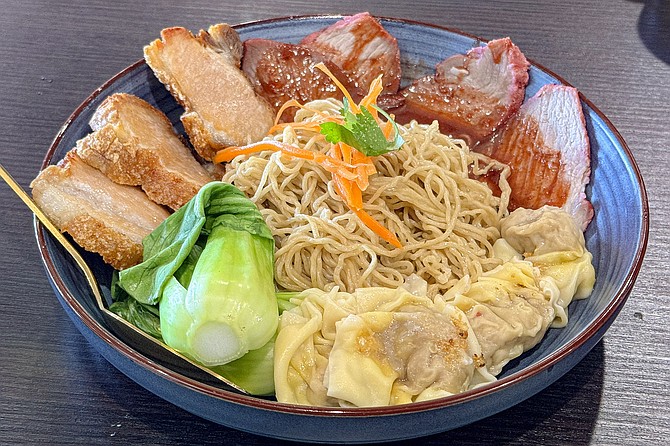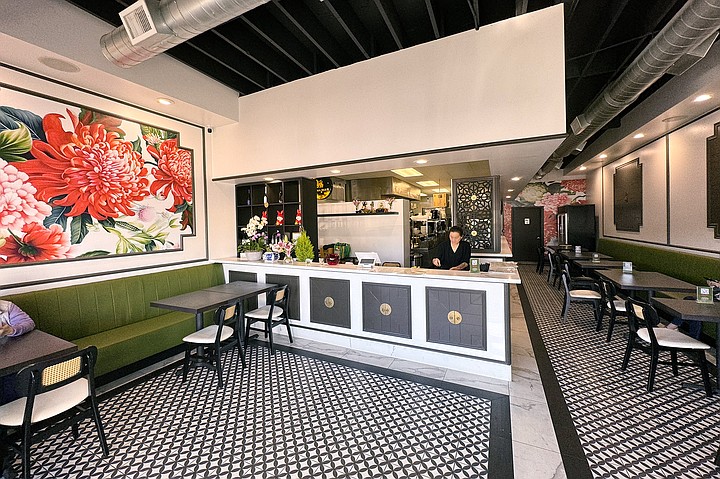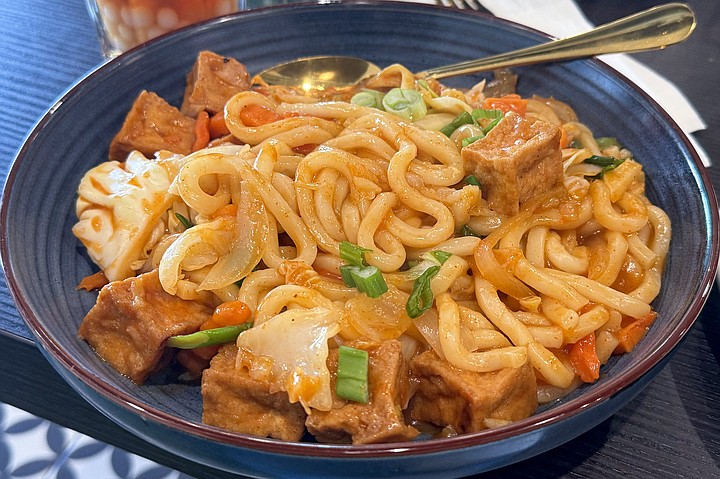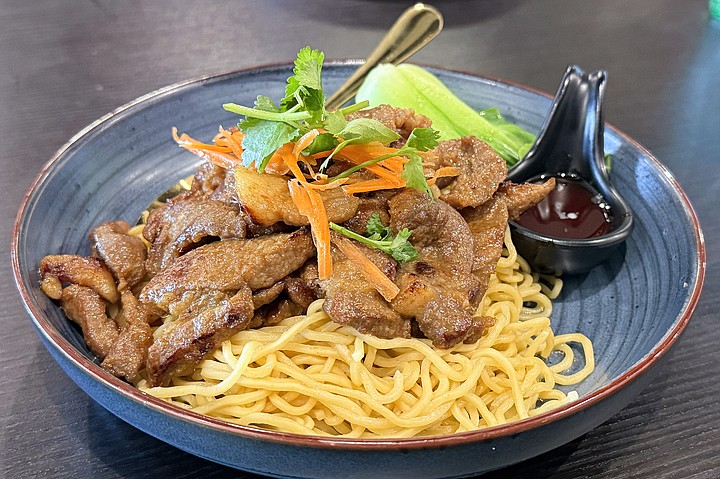 Facebook
Facebook
 X
X
 Instagram
Instagram
 TikTok
TikTok
 Youtube
Youtube

What’s your favorite type of noodle? If you’re not sure, here’s where you can go to find out: La Mesa, home to the newly opened Oodles By The Nood Bar.
The Nood Bar will ring a bell to those who live, work, or carouse around North Park. That pan-Asian noodle counter opened in 2018, nestling into a small, 30th Street storefront with a menu of build your own noodles, incorporating recipes and techniques owing to Thailand, China, Japan, Indonesia, and more.
Diners can expect more of the same at Oodles — in fact, I’ve spotted few major differences between the two menus. The biggest differences between the two restaurants have to do with size and atmosphere. Whereas Nood Bar leans into its casual nature, with Bruce Lee imagery, hightop seating, and bumblebee yellow accents, Oodles offers a more grown-up vibe. Its slightly larger space finds color with murals of larger than life pink and red flowers, to contrast green bench seating, dark woods, and hints of brass.

And, it offers table in addition to counter service. Waiting for my food, I wonder how many Nood Bar customers may now be reunited with the dining concept, after moving to the suburbs in the past five years. I suppose I could count myself in that category. Though, while I used to grab food at Nood Bar after 9pm, Oodles fits more easily into traditional dining hours.
I’m pleased to find much of the food as I remember it: loaded with tender variations of pork, and a bevy of bok choy. Of course, one may still build their own noodle dish, selecting from proteins that also include beef, chicken, tofu, and shrimp, adding to a base of pad Thai, drunken noodles, pad see ew, rad nah, or yakisoba. Even that short list of $14 dishes highlights an assortment of noodles: flat rice, thin rice, and soba. I order the gochujang udon stir fry: which combines thick, Japanese udon noodles, carrots, and cabbage with South Korea’s signature chili paste. The resulting, shiny, orange stir-fry tastes better than my photo suggests.

It's not strictly noodle dishes at Oodles (or Nood Bar for that matter). Customers may also choose among an assortment of rice and fried rice dishes, grilled meat plates, soups, and curries. For example, it’s tough for my wife to stay away from the so-called Sumo Rice ($16): it’s a Japanese-influenced dish of braised pork belly with hard boiled egg and (like virtually everything else) bok choy.
But this concept at its best when you stick to Chef’s Selection noodles. It’s on this part of the menu that you’ll find tried and true favorites including the Indonesia-inspired Mi Goreng, which features stir-fried soba with Chinese sausage, chicken and shrimp ($17); Chinese style Dan Dan noodles, with ramen noodles, char siu, and ground pork ($16); and Malaysian-style laksa curry noodle soup, with thin rice noodles in coconut curry broth with fried tofu, chicken, and shrimp ($17). The origins of a dish like the butter garlic noodle ($17) are tougher to pinpoint: but with slices of grilled lemongrass pork shoulder over steamed soba noodles, it remains a winner.

Still, for my first Oodles visit, I have to highlight the $17 Bamee Pok Pok, a variation of Nood Bar’s Bamee Hang. Both are inspired by Thai street food, wherein the word haeng refers to dry noodles, and pok pok refers to the little street cart that sells them. Both feature steamed bamee (thin egg noodles) and roasted char siupork, but whereas the Nood Bar version adds crushed peanuts and ground pork, Oodles’ Pok Pok dish instead features chicken wontons and crispy pork belly.
That makes a clear winner between the two, and makes the Pok Pok an altogether new noodle favorite. All things being equal, I still prefer the actual udon, then soba noodles, to bamee. But more than anything I like the idea that it need only take a couple visits to Oodles to figure that out.


What’s your favorite type of noodle? If you’re not sure, here’s where you can go to find out: La Mesa, home to the newly opened Oodles By The Nood Bar.
The Nood Bar will ring a bell to those who live, work, or carouse around North Park. That pan-Asian noodle counter opened in 2018, nestling into a small, 30th Street storefront with a menu of build your own noodles, incorporating recipes and techniques owing to Thailand, China, Japan, Indonesia, and more.
Diners can expect more of the same at Oodles — in fact, I’ve spotted few major differences between the two menus. The biggest differences between the two restaurants have to do with size and atmosphere. Whereas Nood Bar leans into its casual nature, with Bruce Lee imagery, hightop seating, and bumblebee yellow accents, Oodles offers a more grown-up vibe. Its slightly larger space finds color with murals of larger than life pink and red flowers, to contrast green bench seating, dark woods, and hints of brass.

And, it offers table in addition to counter service. Waiting for my food, I wonder how many Nood Bar customers may now be reunited with the dining concept, after moving to the suburbs in the past five years. I suppose I could count myself in that category. Though, while I used to grab food at Nood Bar after 9pm, Oodles fits more easily into traditional dining hours.
I’m pleased to find much of the food as I remember it: loaded with tender variations of pork, and a bevy of bok choy. Of course, one may still build their own noodle dish, selecting from proteins that also include beef, chicken, tofu, and shrimp, adding to a base of pad Thai, drunken noodles, pad see ew, rad nah, or yakisoba. Even that short list of $14 dishes highlights an assortment of noodles: flat rice, thin rice, and soba. I order the gochujang udon stir fry: which combines thick, Japanese udon noodles, carrots, and cabbage with South Korea’s signature chili paste. The resulting, shiny, orange stir-fry tastes better than my photo suggests.

It's not strictly noodle dishes at Oodles (or Nood Bar for that matter). Customers may also choose among an assortment of rice and fried rice dishes, grilled meat plates, soups, and curries. For example, it’s tough for my wife to stay away from the so-called Sumo Rice ($16): it’s a Japanese-influenced dish of braised pork belly with hard boiled egg and (like virtually everything else) bok choy.
But this concept at its best when you stick to Chef’s Selection noodles. It’s on this part of the menu that you’ll find tried and true favorites including the Indonesia-inspired Mi Goreng, which features stir-fried soba with Chinese sausage, chicken and shrimp ($17); Chinese style Dan Dan noodles, with ramen noodles, char siu, and ground pork ($16); and Malaysian-style laksa curry noodle soup, with thin rice noodles in coconut curry broth with fried tofu, chicken, and shrimp ($17). The origins of a dish like the butter garlic noodle ($17) are tougher to pinpoint: but with slices of grilled lemongrass pork shoulder over steamed soba noodles, it remains a winner.

Still, for my first Oodles visit, I have to highlight the $17 Bamee Pok Pok, a variation of Nood Bar’s Bamee Hang. Both are inspired by Thai street food, wherein the word haeng refers to dry noodles, and pok pok refers to the little street cart that sells them. Both feature steamed bamee (thin egg noodles) and roasted char siupork, but whereas the Nood Bar version adds crushed peanuts and ground pork, Oodles’ Pok Pok dish instead features chicken wontons and crispy pork belly.
That makes a clear winner between the two, and makes the Pok Pok an altogether new noodle favorite. All things being equal, I still prefer the actual udon, then soba noodles, to bamee. But more than anything I like the idea that it need only take a couple visits to Oodles to figure that out.
Comments